Cu Chi Tunnels are a must-visit for anyone interested in Vietnam's history, especially stories from the Second Indochina War. It's a unique spot that's welcoming for families with kids, making it a great experience for visitors of all ages.
When you visit, you'll dive deep into how the Vietnamese lived and fought during the war, using their wits to combat better-equipped foes with whatever they had on hand, from digging tunnels to facing off against powerful weapons and chemical warfare.
What makes this place really stand out is its incredible network of underground tunnels, stretching over 75 miles. It's like stepping into another world, where every corner tells a story of resilience and strategic warfare, satisfying anyone's curiosity about history or craving for a bit of adventure.
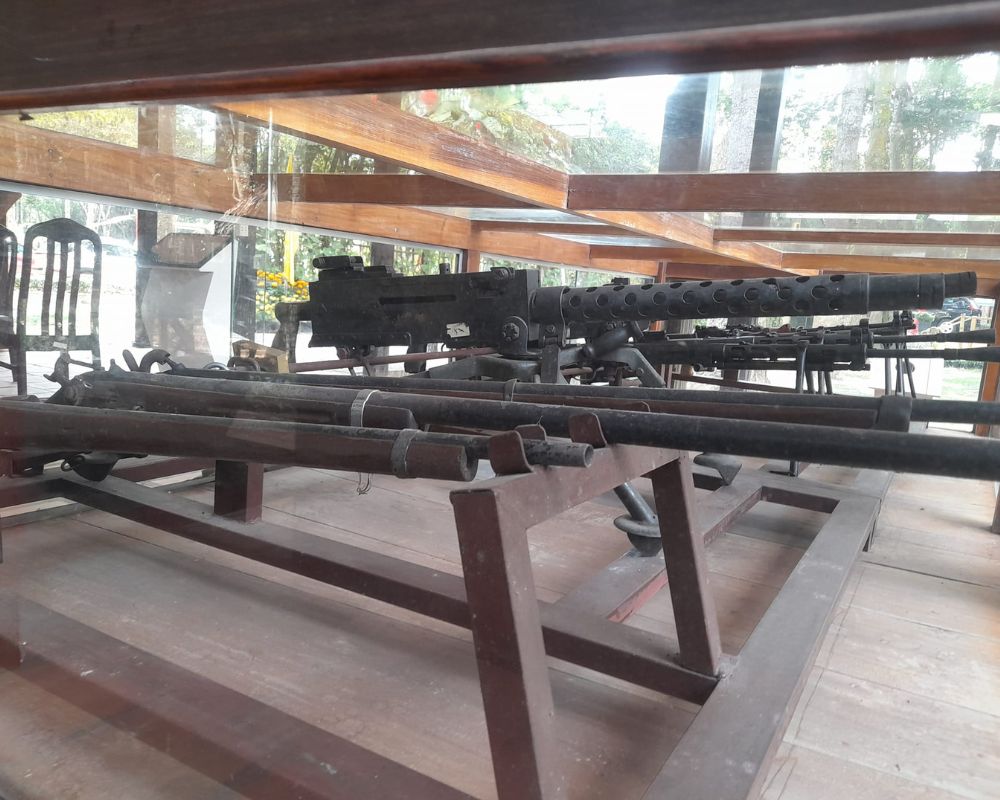
Guns are used in war
There are two main parts of the tunnel system open for visitors – the Ben Dinh and Ben Duoc tunnels. If you're in Ho Chi Minh City, heading to the Ben Duoc tunnel feels like discovering a hidden gem.
It's less crowded and gives you a real, unfiltered look at the Cu Chi Tunnels. Plus, if you're looking for tips and info before your trip, there's a handy guide to the Ben Duoc Tunnel that's got you covered.
Where is the Ben Duoc Tunnels?
Situated near the Saigon River in the Cu Chi district, the Ben Duoc Tunnels are approximately 70 kilometers northwest of Ho Chi Minh City. This strategic location allowed the Viet Cong to launch surprise attacks and quickly retreat into the safety of the tunnels, which spanned hundreds of kilometers and included multiple levels.
Today, the site serves as a historical monument, offering visitors a stark reminder of the war's complexities and the enduring spirit of the Vietnamese people.
- Address: Group 6 - Hamlet QL22, Phuoc Thanh, Cu Chi, Ho Chi Minh City
- Ticket price: Adult: 90,000 VND/person; Children: 10,000 VND/person
- Opening Hours: 7:30 AM–5 PM
- Phone: 02837948830
- Map: https://maps.app.goo.gl/uPiy43FMj8t2EmzP7
History of Ben Duoc Tunnels
The Ben Duoc Tunnels are a significant part of the larger Cu Chi Tunnel network located in the Cu Chi District, northwest of Ho Chi Minh City (formerly Saigon), Vietnam. This vast underground complex played a crucial role during the Vietnam War (known in Vietnam as the American War).
The history of the Ben Duoc Tunnels is intertwined with the resilience and ingenuity of the Vietnamese people during this tumultuous period.
Unlike the more frequented Ben Dinh tunnels, which have been somewhat modified to accommodate tourists, the Ben Duoc tunnels remain closer to their original state, offering a more authentic glimpse into the past.
The tunnels at Ben Duoc were specifically designed for the war effort, serving as a command center, living quarters, and a concealed route for movement and supply chains for the Viet Cong soldiers and the local population.
The inception of the tunnel network can be traced back to the late 1940s, during the struggle against French colonial rule, but it was significantly expanded during the 1960s to combat American and South Vietnamese forces.
The tunnels were dug by hand, a testament to the determination of the Vietnamese people. They spanned an extensive area, with some estimates suggesting that the total length of the Cu Chi tunnels could reach up to 250 kilometers (about 155 miles).
>>Read more: Cu Chi Tunnel Tour Excursion From Phu My Port
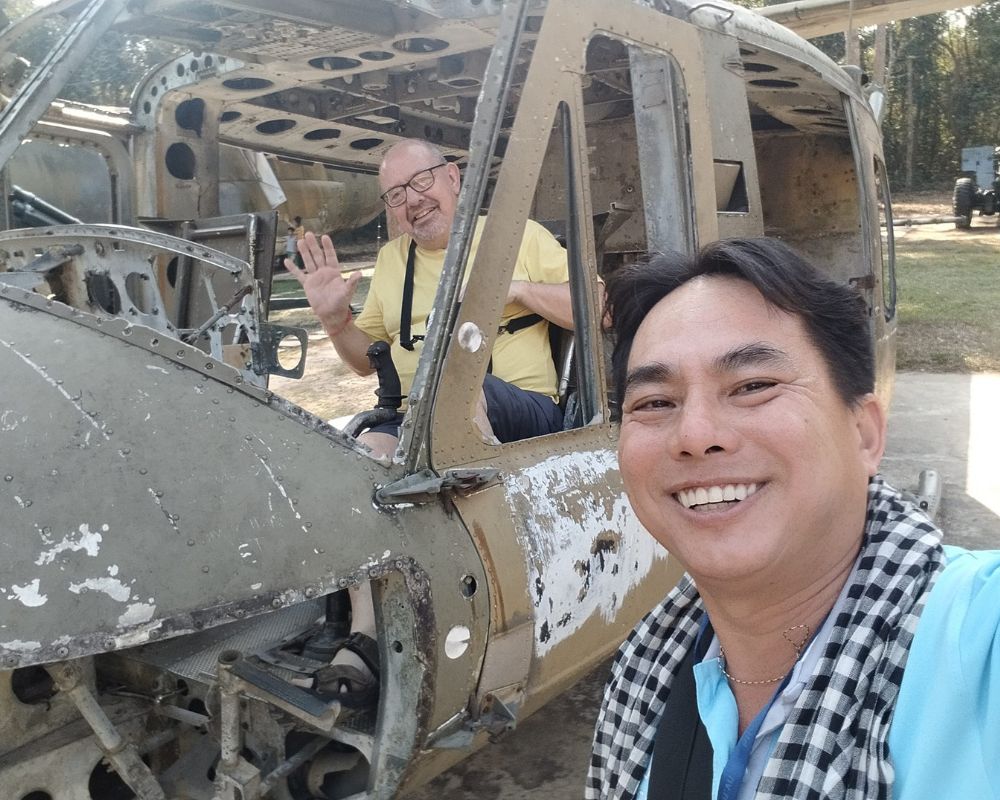
Take pictures with old fighter plane
The Ben Duoc section of the tunnels was crucial for several reasons:
Strategic Military Use: The tunnels were used to conduct guerrilla warfare, allowing soldiers to move undetected and launch surprise attacks. They were also used to transport supplies, communicate between units, and evade enemy forces.
Survival: Inside the tunnels, the Viet Cong built living quarters, hospitals, and storage facilities. This allowed them to withstand bombings and chemical attacks, as well as to maintain a prolonged resistance against a technologically superior enemy.
Local Support and Involvement: The tunnels at Ben Duoc highlight the involvement of the local population in the war effort. Civilians, including women and children, played a key role in constructing and maintaining the tunnels, demonstrating a widespread commitment to the cause.
The Ben Duoc Tunnels, today, serve as a war memorial and a museum, offering visitors a poignant look at the ingenuity and resilience of the Vietnamese people during the war.
They provide a stark contrast to the more sanitized version of the tunnels at Ben Dinh, presenting a raw and unfiltered look at the conditions soldiers and civilians faced.
Visiting the Ben Duoc Tunnels offers a unique perspective on the complexities of war, the spirit of the Vietnamese people, and the lengths to which they went to secure their independence and sovereignty.
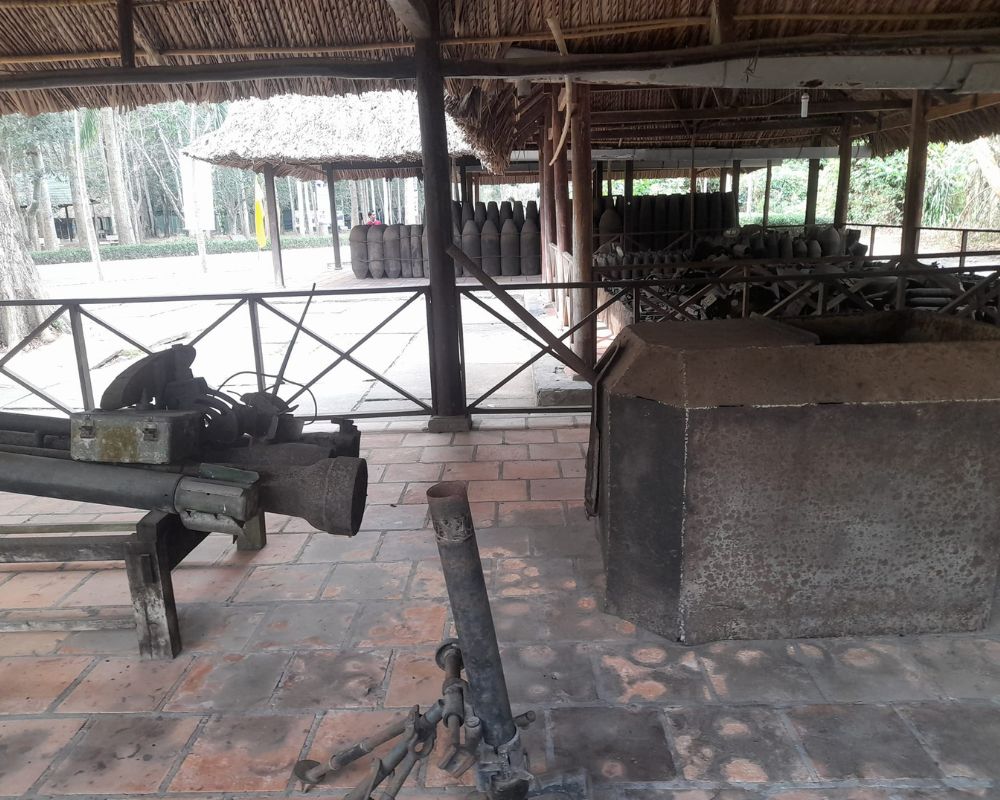
War remnants of ammunition
How to get to Ben Duoc tunnels?
To reach the Ben Duoc tunnels from Ho Chi Minh City, you have several options depending on your preference for convenience, speed, or experiencing local culture. Here's how you can get to the Ben Duoc tunnels:
1. By Bus:
Taking a bus is an affordable and authentic way to travel. You can catch a bus from the Ho Chi Minh City bus station. Look for buses going towards Cu Chi District.
You may need to ask around for the specific bus number as these can change, but bus 13 to Cu Chi bus station and then bus 79 to Ben Duoc is a commonly used route. Remember, bus travel will give you a real taste of local life but may require a bit of patience and flexibility because of wasting your time.
2. Motorbike or Scooter Rental:
For those who prefer a bit more adventure and freedom, renting a motorbike or scooter to drive to the Ben Duoc tunnels is a great choice. The ride takes about 1.5 to 2 hours, depending on traffic and your starting point in Ho Chi Minh City.
Make sure you have a map or GPS and are comfortable navigating Vietnamese roads. This option allows you to explore at your own pace and take in the scenery.
3. Private Car or Taxi:
Hiring a private car or taking a taxi is the most comfortable and hassle-free option but also the most expensive. It's convenient, especially for groups or families, and you can arrange for the driver to wait and take you back to Ho Chi Minh City after your visit.
Make sure to agree on a price beforehand or use a reputable taxi company with metered fares.
You can see more about Private Car Rental With Driver Cu Chi Tunnels Full Day
4. Tour Group:
Joining a tour group is a hassle-free way to visit the Ben Duoc tunnels, with many agencies in Ho Chi Minh City offering half-day or full-day tours.
This option usually includes transportation, a guide who can provide historical context, and sometimes additional stops at other points of interest. It's a great way to meet other travelers and learn more about the tunnels and the area's history without worrying about logistics.
You can see more at our Cu Chi Tunnels And Ho Chi Minh Full Day Tour
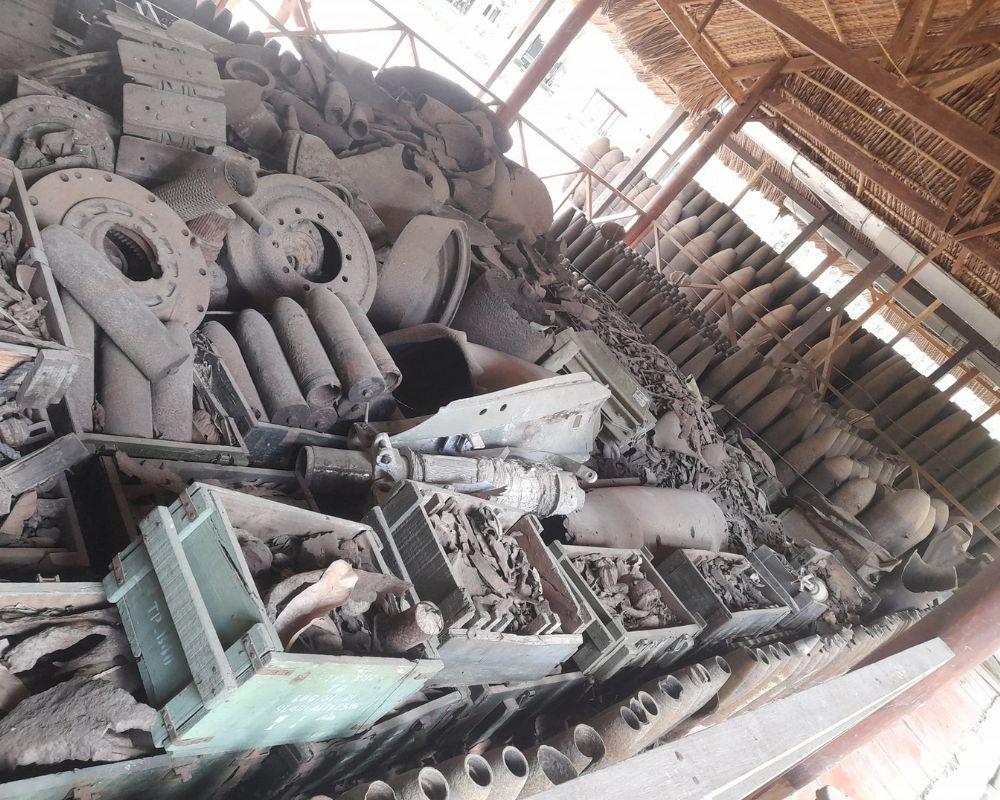
War ruins
What to do around Ben Duoc?
1. Explore the Open-Air Museum:
Begin your visit with the open-air museum, where you’ll find an array of bombs used by enemy forces and the weapons deployed by Vietnamese soldiers for defense. This display offers a stark reminder of the war's intensity and the challenges faced by those living through it.
2. Watch Documentaries and Listen to Stories:
After entering, you'll have the chance to watch documentaries that give you a deeper understanding of the Cu Chi tunnels' significance and history.
Listening to guides dressed in traditional Vietnamese attire, such as Ba Ba blouses and rubber flippers, adds a personal touch to the narratives, making the history come alive.
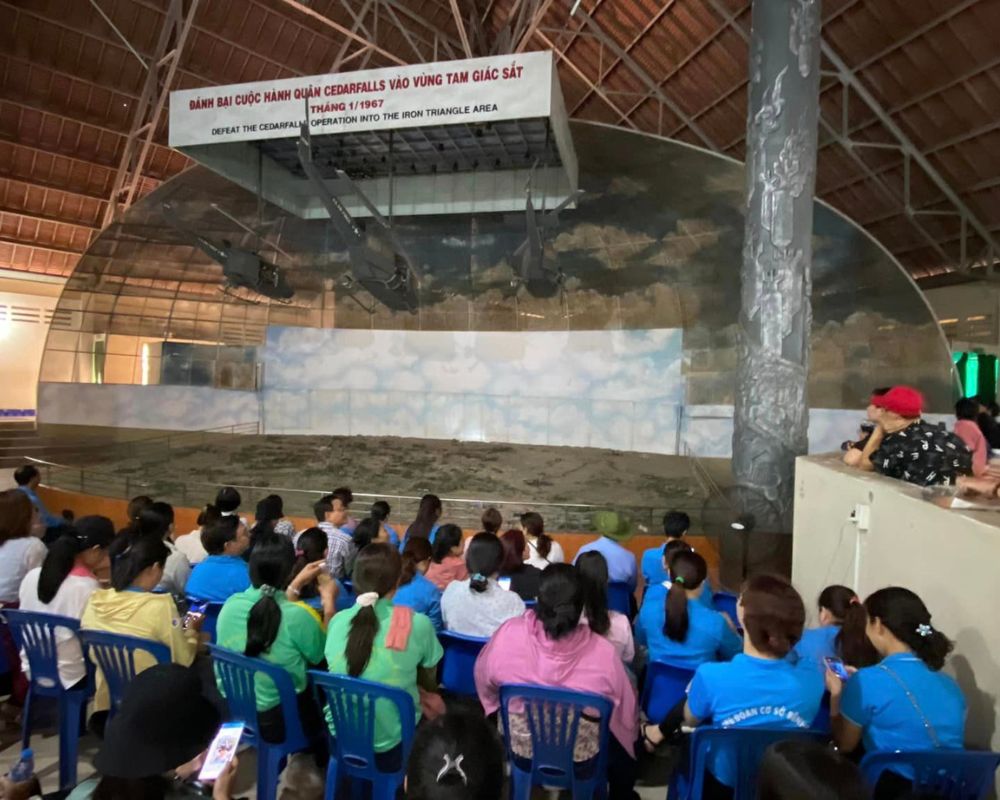
Tourists watch Documentaries
3. Tour the Subterranean Complex:
One of the highlights of your visit will be exploring the underground network itself.
You’ll navigate through narrow tunnels, visit subterranean living quarters, and see firsthand the ingenuity of the tunnel designs, including the Hoang Cam kitchen, famed for its smoke-dispersal system that prevented detection during cooking.
4. Sample War-Time Cuisine:
Take a moment to sample the simple yet significant food that sustained guerilla fighters, like boiled cassava with sesame salt and Vietnamese style onigiri. Eating this food offers a tangible connection to the past, providing insight into the daily lives of those who called the tunnels home.
5. Discover Ingenious Booby Traps:
The area around the tunnels is dotted with examples of the booby traps used during the war. These cleverly designed traps were a key element of guerilla warfare, and seeing them up close is both educational and sobering.
6. Take Photos and Soak in the Atmosphere:
The site's dense woods and historical remnants provide a serene yet poignant backdrop for reflection and photography. Walking the paths, you can almost imagine the bustling underground activity and the resilience of those who lived and fought here.
Visiting the Ben Duoc tunnels not only educates visitors about the technical and strategic aspects of the tunnel system but also offers a profound look into the human spirit's resilience and creativity under duress.
Whether you’re a history buff, a culture enthusiast, or simply curious, the Ben Duoc tunnels offer a comprehensive and engaging experience
